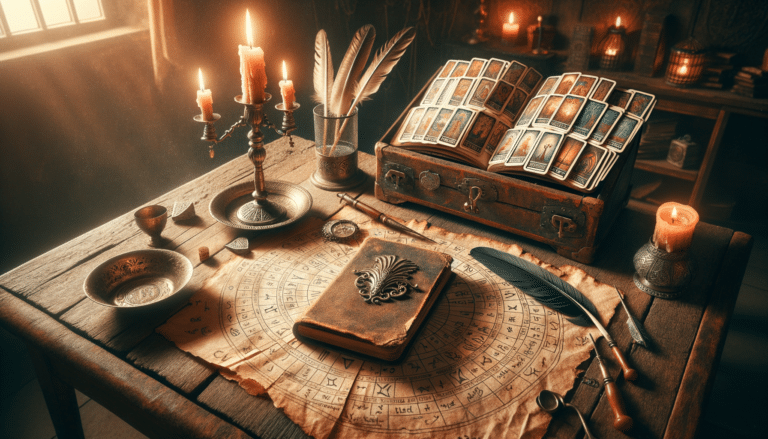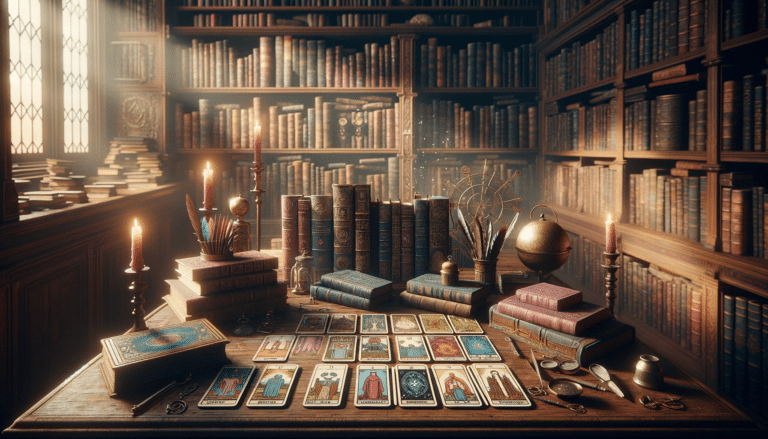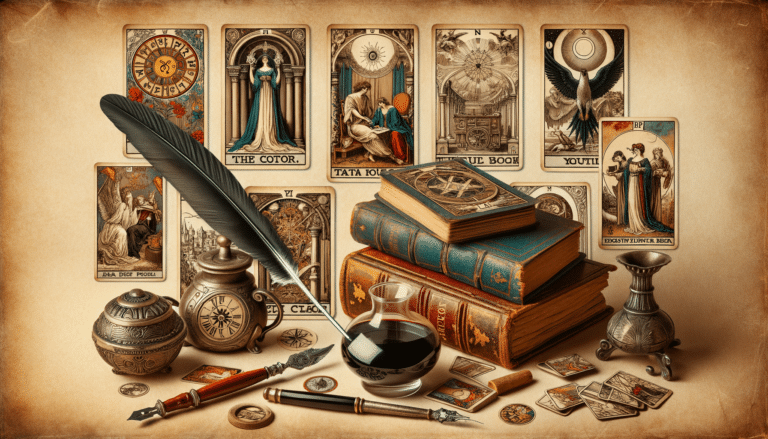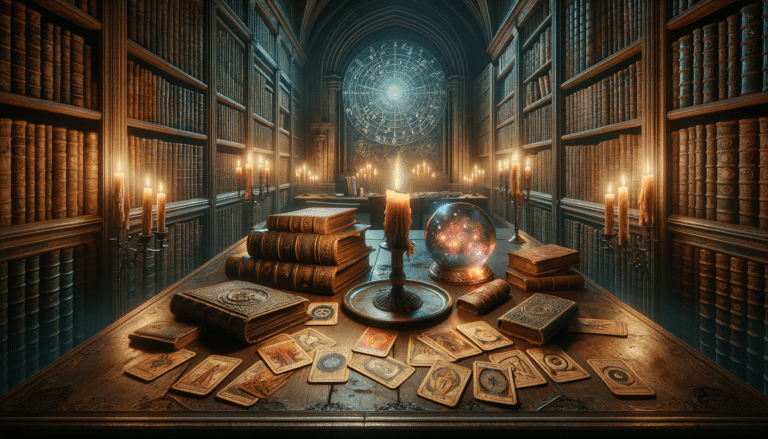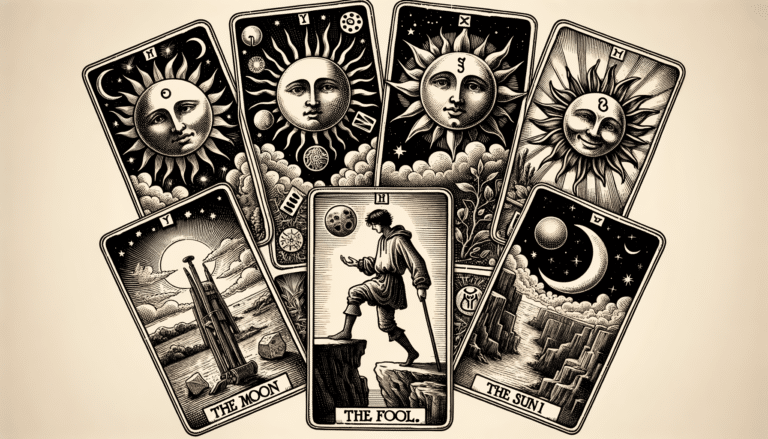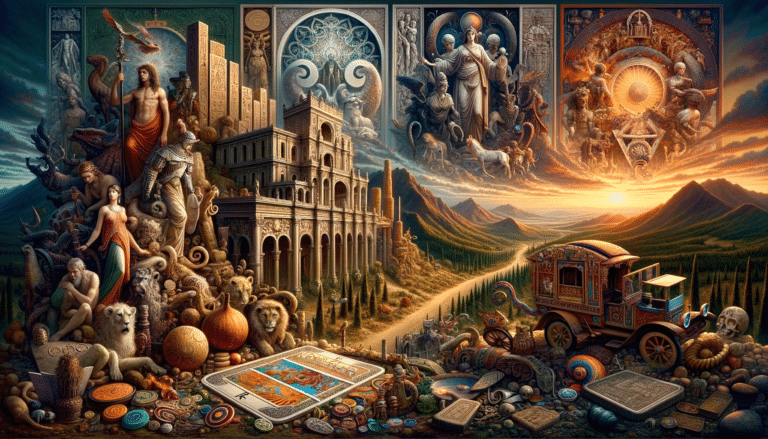Exploring the Medieval Influence on Tarot Cards Origins
As a traveler through time, you’re about to uncover the layered past of tarot cards, where medieval symbolism is the map leading you to hidden treasures of knowledge. You’ll see how the vivid imagery on the cards reflects the societal structures, religious beliefs, and mystic practices of the Middle Ages.
Delve into the roles of court cards, mirroring the feudal hierarchies of the time, and trace the tarot’s journey across Europe, where it evolved from game to guide.
Understand the church’s wary stance as tarot edged towards occult and divinatory uses.
Let’s explore how the medieval influence on tarot cards has shaped the tarot’s complex history, offering you a window into the souls and spirits of centuries past.
Key Takeaways
- Tarot cards in medieval times were influenced by religious, cultural, and social symbols, reflecting the intertwining of spiritual and worldly views in medieval life.
- The court cards in tarot mirror the rigid feudal system of medieval times, representing various levels of nobility and social class distinctions.
- Tarot cards spread through European trade routes during the late medieval period, absorbing local symbols and allegories and offering unique insights into the European psyche.
- The church had a complex attitude towards tarot, denouncing mysticism but also contributing to its appeal through suspicion and condemnation.
Origins of Tarot Imagery
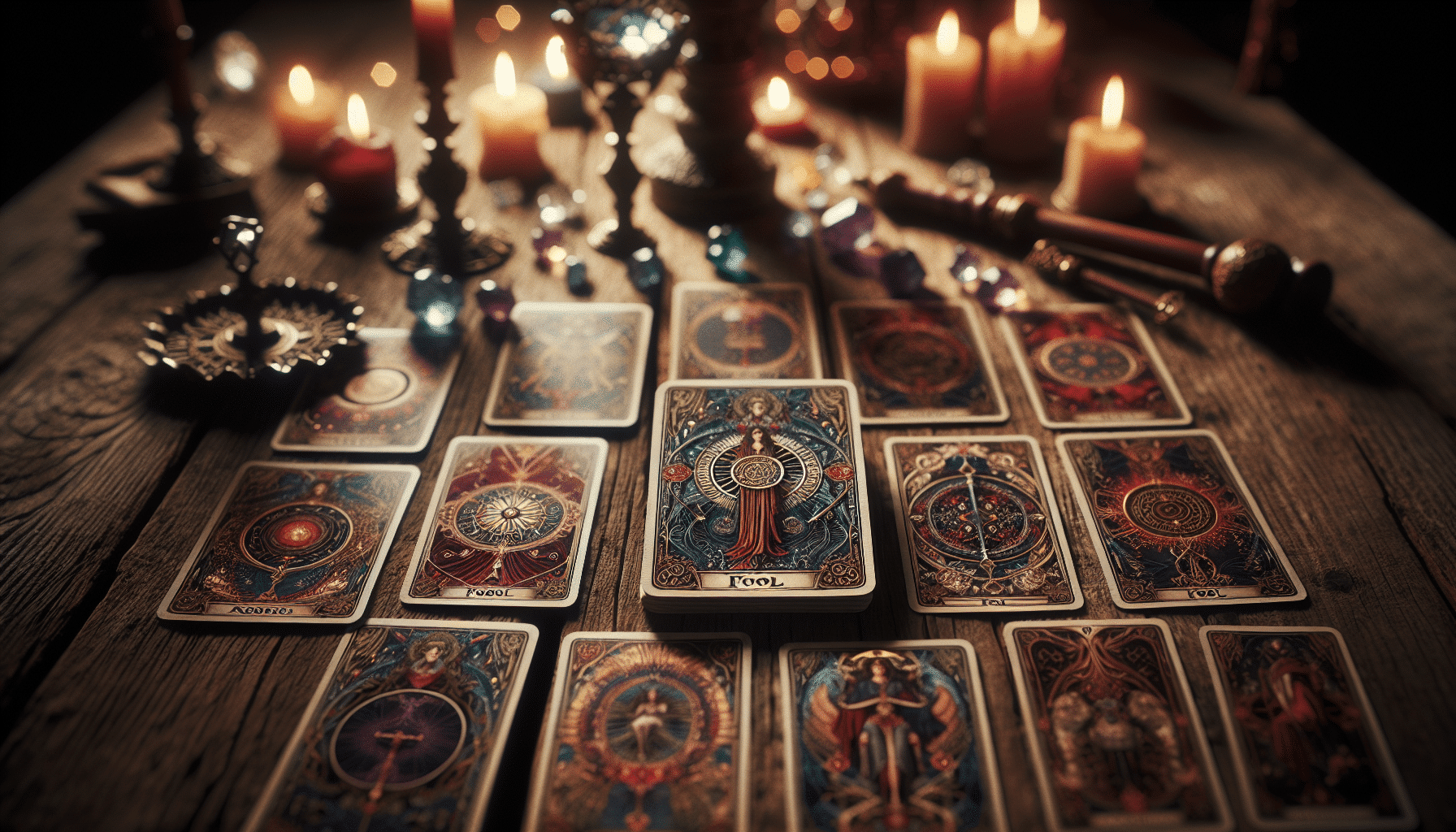
Within the rich tapestry of medieval iconography, you’ll find the origins of tarot imagery rooted in the period’s religious, cultural, and social symbols. These images weren’t just for aesthetic appeal; they held significant meanings and reflected the spiritual beliefs of the time.
As you dive deeper, you’ll notice that the cardinal directions – North, South, East, and West – often influenced the placement and symbolism of figures within the cards. Medieval society was steeped in the interpretation of such directions, with each one holding specific connotations. For example, East might’ve been associated with renewal and beginnings, akin to the sunrise. Tarot imagery absorbed these meanings, adding layers of interpretation to the cards.
Furthermore, the pagan elements prevalent during the medieval era also found their way into tarot. Earth, air, fire, and water – fundamental components of nature and pagan belief systems – were represented symbolically within the cards. These elements provided a framework for understanding the world and could guide the interpretation of the cards.
You’re looking at a historical amalgamation when you shuffle through a tarot deck. The cards reflect a time when spiritual and worldly views were visually intertwined, offering insights that go beyond mere fortune-telling into the psyche of medieval life.
Tarot and Medieval Symbolism
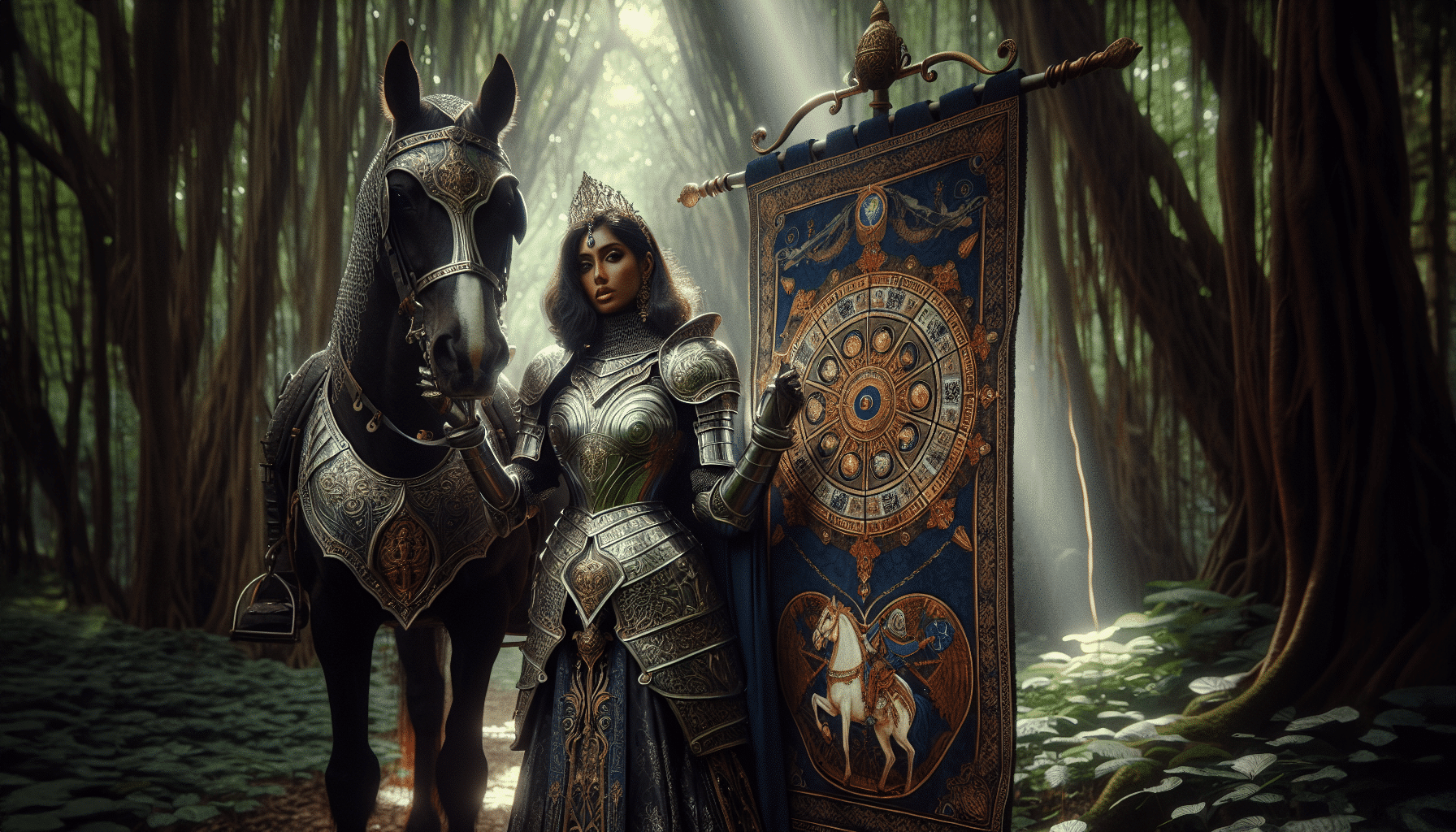
While you explore the medieval origins of tarot, you’ll find that the symbolism woven into the cards offers a direct reflection of the era’s allegorical language and societal values. The images aren’t just random; they’re steeped in the medieval worldview, incorporating elements of the medieval bestiary and the spiritual symbolism often found in Gothic architecture.
Take, for example, the frequent appearance of animals in the tarot. These aren’t merely decorative; they’re part of a complex language of symbols. Lions might represent nobility or courage, echoing their use in heraldry, while dogs could symbolize loyalty or vigilance, as they would in a medieval bestiary.
The structured beauty of Gothic architecture also finds its way into tarot imagery. The ornate, towering spires and intricate stonework that define this style can be seen in the cards, representing a bridge between the earthly and the divine, a concept central to medieval spirituality.
Here’s a table summarizing some common medieval symbols found in tarot cards:
| Tarot Card | Symbol | Medieval Significance |
|---|---|---|
| The Tower | Spire | Aspiration to heaven |
| The Chariot | Horses | Power and movement |
| The Lovers | Garden | Love and fertility |
| The Hermit | Lantern | Search for knowledge |
| Strength | Lion | Courage and authority |
Understanding these symbols gives you deeper insight into the medieval mindset and how it manifests in the tarot’s intricate artwork.
Check out our Tarot Cards & Oracle Decks here…
Court Cards and Feudal Hierarchy
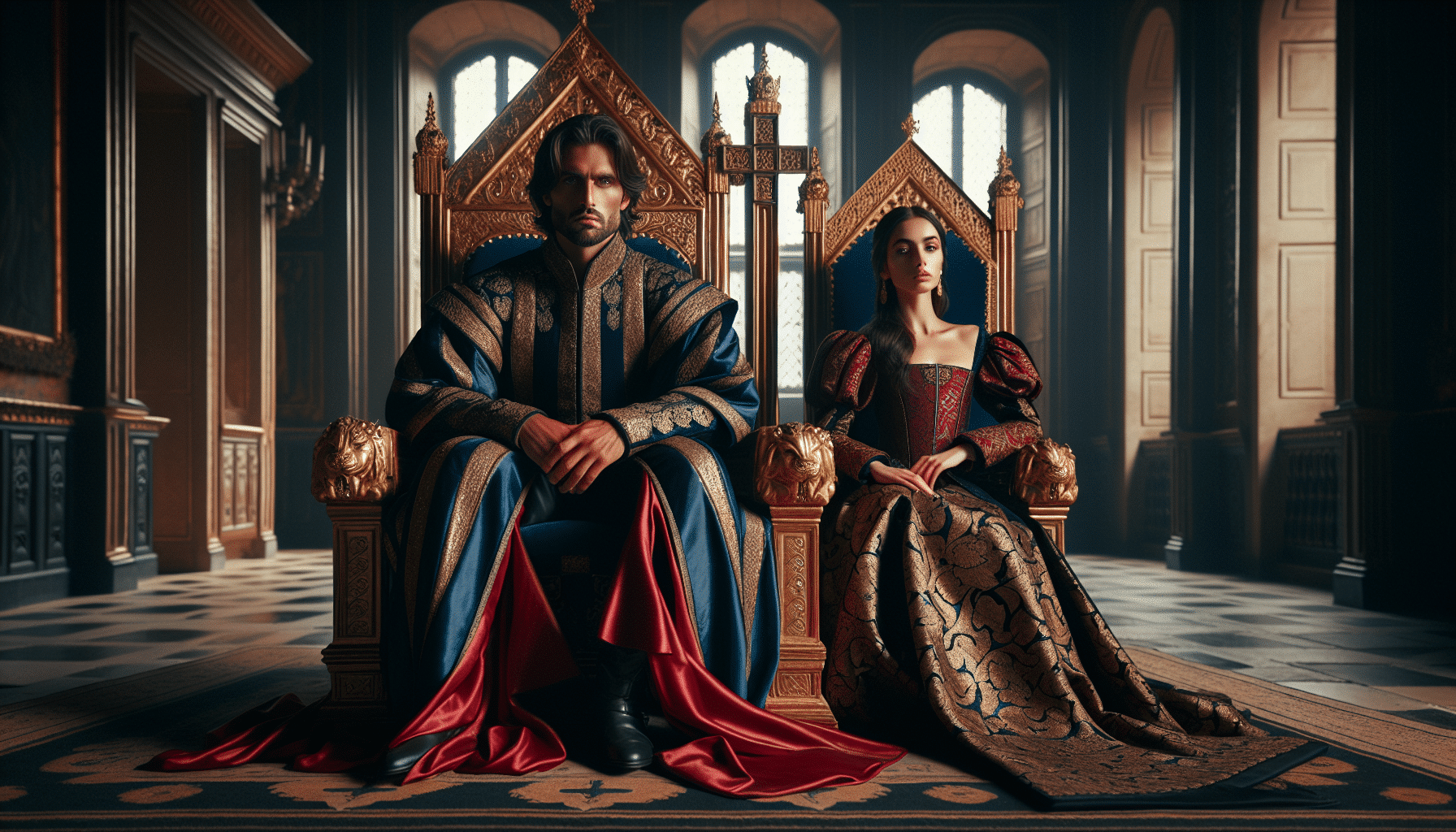
You’ll find that the court cards in a tarot deck mirror the rigid feudal system of medieval times. These cards represent various levels of nobility and reflect the social class distinctions of that era.
As you explore their meanings, you’ll uncover how hierarchical symbolism is intricately woven into the tarot’s history.
Nobility Representation
As you delve into the court cards of the tarot, it’s evident that they mirror the rigid feudal hierarchy of medieval society. These cards, often used in aristocratic games, are steeped in the imagery and roles of nobility. Kings and Queens sit at the apex, much like the sovereigns who issued royal decrees.
Below them, the Knights and Pages represent lesser ranks within the nobility, akin to vassals serving their liege lord.
Each suit’s court cards encapsulate the division of power and social structure that was the backbone of medieval governance. As you handle these cards, you’re not just shuffling pieces of a game; you’re interacting with a symbolic representation of a bygone world, where each draw could reflect the fates of those within a courtly realm.
Hierarchical Symbolism
Every one of these court cards serves as a distinct emblem of the layered feudal system, inviting you to reflect on the hierarchical symbolism entrenched in medieval society. As you delve into tarot, you’ll notice that the court cards – Pages, Knights, Queens, and Kings – mirror the ranks within a feudal court.
-
Pages: Symbolize messengers or squires, representing the potential and messages pertaining to their suit.
-
Knights: Stand for chivalry and action, often reflecting the movement and conflict inherent in their domain.
-
Queens and Kings: Embody authority and governance, with Queens reflecting the nurturing aspect of power, and Kings the authoritative rule.
These Arcana interpretations offer modern parallels, allowing you to draw connections between past and present social structures in your readings.
Social Class Reflection
While the hierarchical symbolism of tarot’s court cards offers a window into medieval social structures, they also invite you to consider how these archetypes reflect upon contemporary notions of class and power.
The figures of the King, Queen, Knight, and Page represent layers of feudal authority, each with an implied status and role. From a peasant perspective, these cards might’ve symbolized the distant and powerful elite, shaping much of daily life without direct interaction.
Today, you can use them to explore your own place within society’s framework, acknowledging the enduring influence of historical class divisions. Understanding these cards’ origins enhances your grasp of their symbolic weight, adding depth to your interpretation of their meaning in modern contexts.
Learn more with these tarot books here…
Tarot’s Journey Through Europe
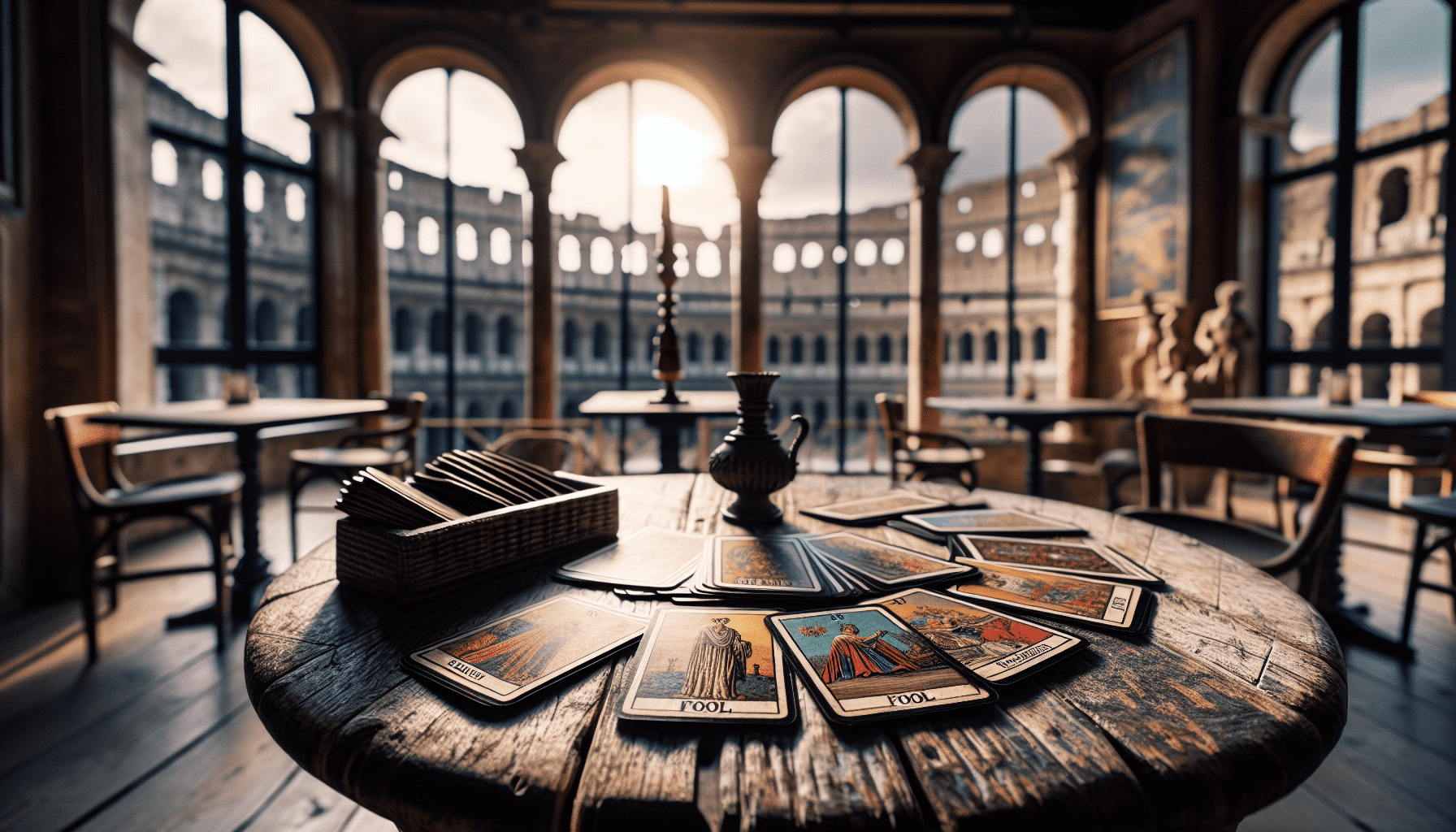
Embarking on its continental voyage, you’ll discover that tarot cards infiltrated European culture primarily through the trade routes of the late medieval period. As the Renaissance spread, these enigmatic cards became intertwined with the fabric of society, not just as tools for games but also as means for divination, reflecting the mystical inclinations of the time. The allure of tarot was magnified by Gypsy lore, with their mysterious aura contributing significantly to the tarot’s mystique and perceived power.
To make this history more engaging, consider these intriguing points:
- Tarot first emerged in Italy during the 15th century, with the oldest surviving cards dating back to this time.
- The cards were soon adopted by French and Spanish nobility, evolving into various regional styles and uses.
- Throughout their spread, tarot cards absorbed local symbols and allegories, becoming a cultural tapestry that offered unique insights into the European psyche.
You’re not just learning about a deck of cards; you’re unraveling a rich tapestry of history that reflects deep cultural and spiritual undercurrents of an entire continent. By tracing the tarot’s journey through Europe, you’re witnessing the transformation of a simple card game into a profound tool for personal and philosophical reflection.
Learn even more secrets of history of tarot cards here…
Influence of Medieval Mysticism
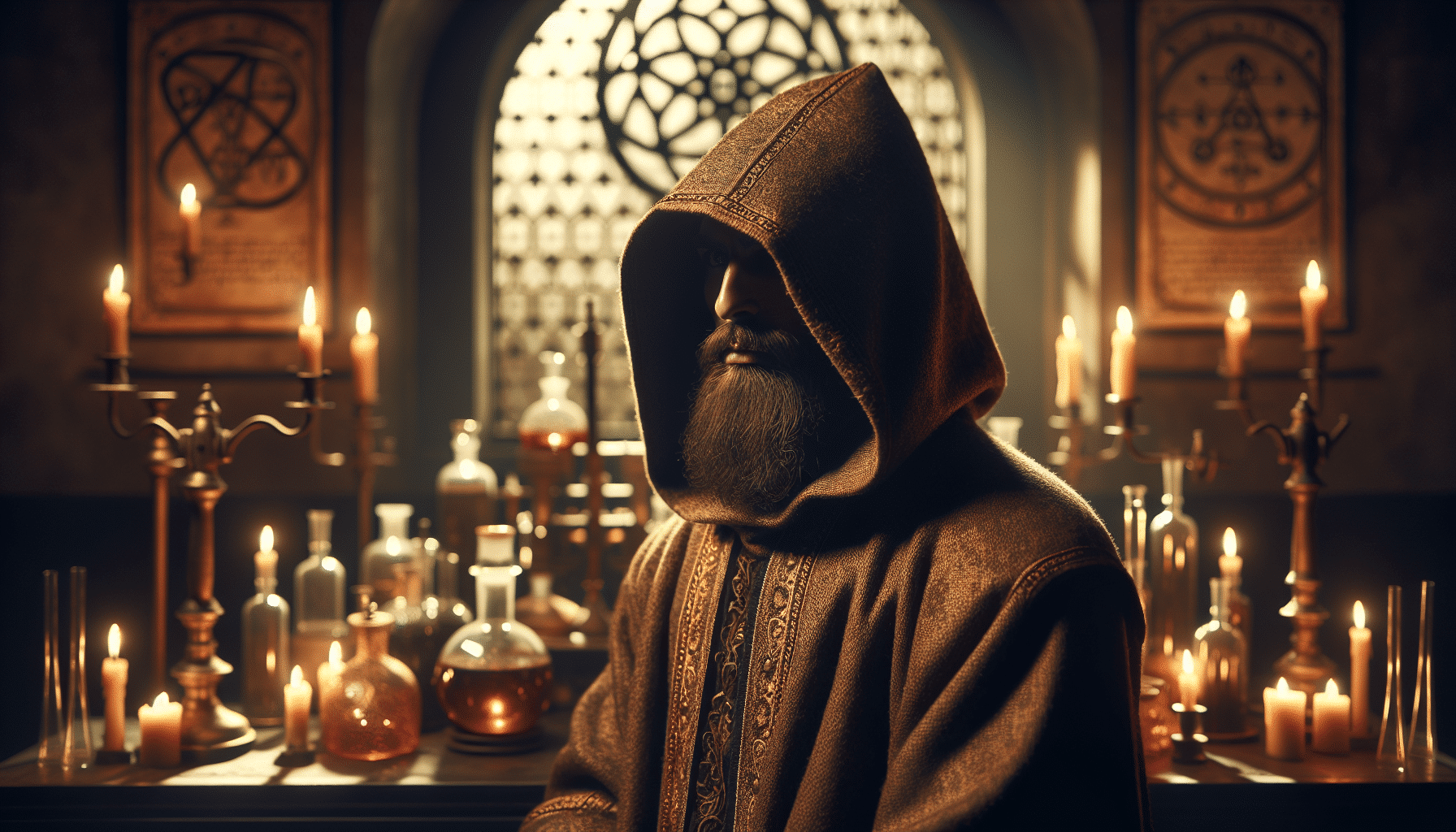
As you explore the history of tarot cards, you’ll find that medieval mysticism left its mark through enigmatic symbols whose origins stir curiosity.
You’ll see how the Church’s stance on these mystical elements fluctuated, often influencing their use and interpretation.
Moreover, the impact of Hermeticism reveals a rich tapestry of philosophical thought intertwined with the evolution of tarot imagery.
Mystical Symbols Origin
You’ll dive into the depths of medieval mysticism to uncover the esoteric symbols woven throughout the tarot’s rich tapestry. The tarot’s iconography didn’t spring from a void; it’s deeply entrenched in the mystical traditions of the Middle Ages.
As you explore, you’ll find:
- Gnostic traditions that emphasize secret knowledge and spiritual insight
- Alchemical allegories representing transformation and the union of opposites
- Arcane symbols that were once believed to hold the keys to the universe
These elements aren’t just medieval relics; they’re the threads that connect the tarot to a time when the mystical and the mundane were closely intertwined.
Understanding these symbols can enrich your perspective of the tarot’s messages and its historical significance.
Church’s Stance
While the church officially denounced many forms of mysticism, it couldn’t entirely suppress the influence these esoteric practices had on the development of tarot imagery. Despite papal decrees that sought to curb occult interests, the symbolism found in tarot cards often reflected the mystical undercurrents present during the Middle Ages.
You’ll find that the Inquisition’s attitudes towards such practices were complex and varied, but their efforts to eradicate these beliefs didn’t erase the allure that the mysterious held for many people. The imagery in the cards, subtly infused with medieval mysticism, hints at a silent dance between the church’s public condemnation and the private fascination that continued to thrive.
This tension contributed to the rich tapestry from which modern tarot draws its enigmatic appeal.
Hermeticism Impact
Many of the symbols you encounter on tarot cards are steeped in the principles of Hermeticism, a medieval mysticism that profoundly shaped their development.
Hermeticism’s influence is visible through:
-
The integration of occult philosophies, which offer a deeper, esoteric meaning behind the imagery.
-
Alchemical allegories that manifest in the cards, hinting at transformation and the pursuit of enlightenment.
-
The mystical synthesis of art and spirituality, which compels you to look beyond the material world.
Hermeticism, with its rich tapestry of knowledge, has left an indelible mark on the tarot. The cards don’t just predict; they serve as a bridge between the mystical and the mundane, urging you to explore the profound depths of both the universe and yourself.
The Church’s Stance on Tarot
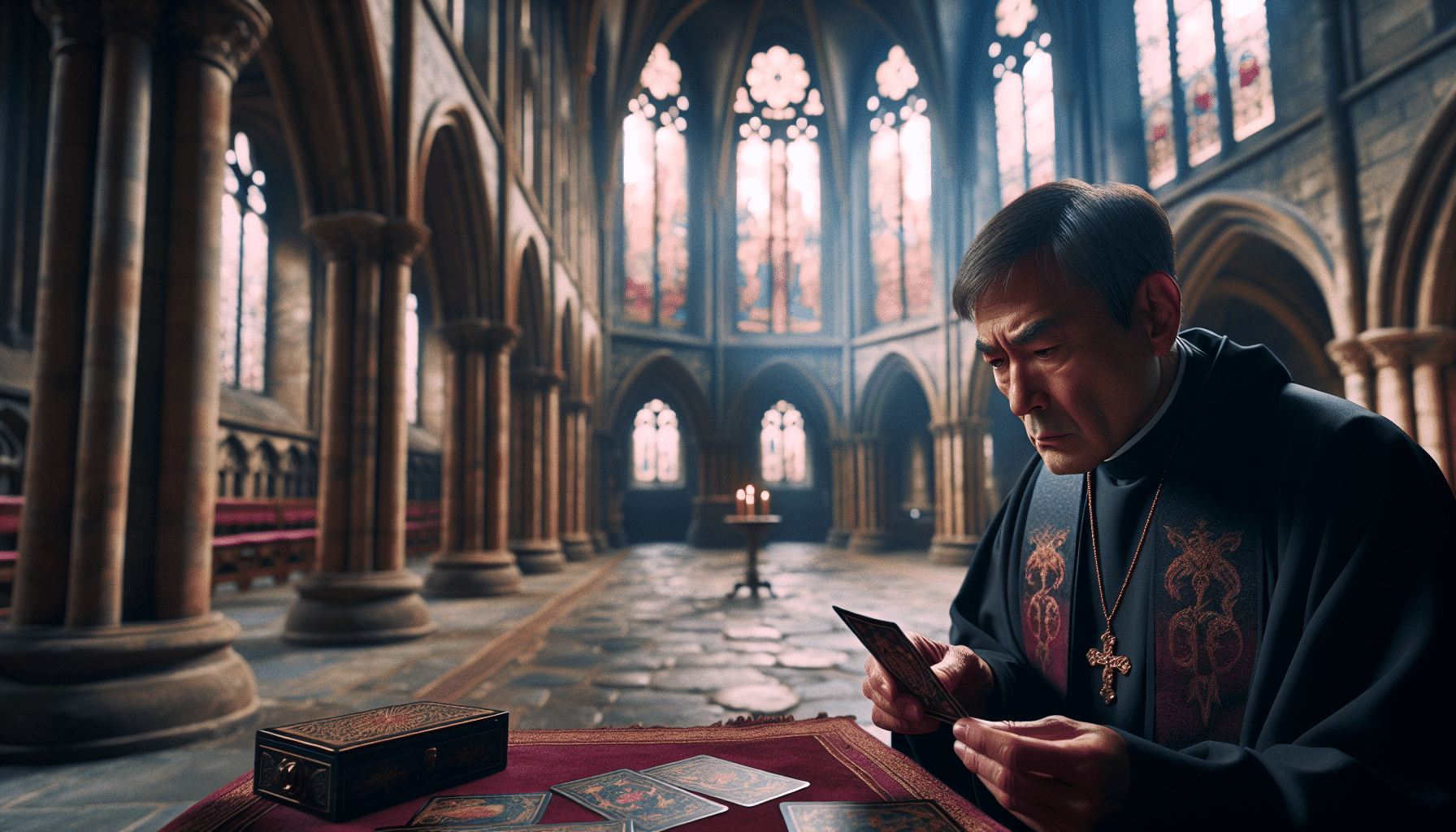
Throughout the Middle Ages, the Church’s stance on tarot cards was one of suspicion and condemnation, as they were often associated with heresy and witchcraft. This view didn’t emerge from a void; rather, it was the result of a complex interplay between emerging esoteric practices and the Church’s efforts to maintain religious orthodoxy.
Church condemnation of tarot and similar practices was cemented through various Papal pronouncements, which aimed to curb the spread of what the Church deemed occult and pagan practices.
You must understand that the Church wielded immense power during this period, and its declarations held significant sway over the populace. Tarot, with its mysterious symbols and potential for divination, was seen as a direct challenge to the Church’s authority. The idea that cards could reveal divine knowledge was anathema to an institution that positioned itself as the sole intermediary between God and humanity.
To grasp the intensity of the Church’s disapproval, imagine the tarot as a book whose pages the Church believed contained heretical text. It wasn’t just about cards; it was about control, and anything that threatened that control was met with swift and decisive action.
This historical tension between tarot and the Church shaped much of the cards’ early history and the attitudes that surrounded them.
Transition to Divination Practices
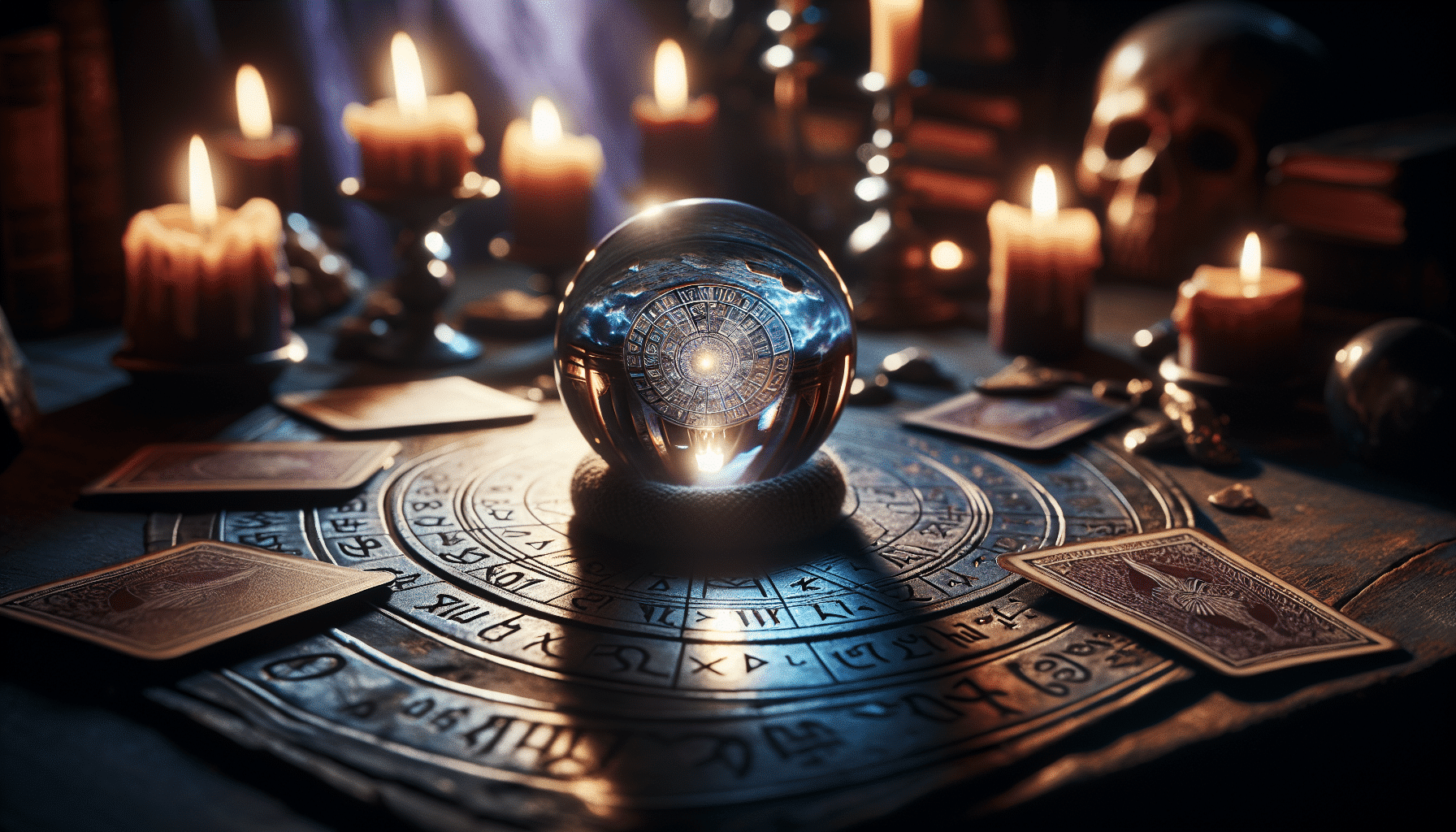
You’ll find that the tarot’s journey into the realm of divination began as a gradual shift from simple card playing to a tool for seeking insight. As you delve into the narrative of this transformation, you’ll discover the pivotal moments that marked the card games evolution. The Renaissance, known for its revival of classical arts and sciences, also brought about a renewed interest in mysticism and the occult. This cultural reawakening influenced the way people perceived tarot cards.
Here are three key developments that propelled tarot cards towards their role in divination:
-
Renaissance Symbolism: The era’s philosophical and artistic movements embedded deeper meaning into the imagery of the tarot, making them ripe for interpretive uses.
-
Occult Associations: With the rise of interest in the esoteric, tarot cards were linked to ancient wisdom and secret knowledge, paving their way to become tools for divination.
-
Divinatory Texts: The publication of divination manuals and texts specifically associating tarot cards with fortune-telling techniques solidified their place in predictive practices.
Understanding these influences helps you grasp how tarot cards transcended their medieval origins as mere entertainment to become a conduit for accessing the unknown.
Conclusion
In the tapestry of time, you’ve traced the thread of tarot back to medieval roots, where symbols danced with mysticism.
As you shuffle through history, remember the cards’ journey from courtly games to cosmic gateways.
They whisper secrets of a bygone era, inviting you to ponder life’s enigma.
And though the Church once cast a wary eye, tarot’s legacy endures – a bridge between past and present, guiding seekers toward their hidden fates.

About The Author – Allen Hill
Allen Hill, the force behind Unknown Truth Tarot, has a YouTube following 6-times bigger than the population of his hometown, Miamisburg, Ohio. From his spiritually rich blog on Tarot and crystals to his role as CEO of The Unknown Truth Tarot Metaphysical Shop, Allen’s passion for the metaphysical shines through.
A master Tarot reader and “crystal junkie,” Allen is also a devoted dad to Dylan, 10, and Destiny, 24. When he’s not immersed in the world of Tarot and crystals, he enjoys poker and video gaming sessions, often humorously outplayed by Dylan.
Follow Allen on Twitter, Instagram, Facebook, TikTok, and subscribe to his Unknown Truth Tarot YouTube channel to join him on a journey of spiritual growth and self-discovery.

